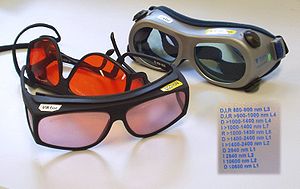
EN 207
Encyclopedia

Laser safety
Laser safety is safe design, use and implementation of lasers to minimize the risk of laser accidents, especially those involving eye injuries. Since even relatively small amounts of laser light can lead to permanent eye injuries, the sale and usage of lasers is typically subject to government...
eyewear. Any laser eye protection sold within the European Community must be certified and labeled with the CE mark
CE mark
CE marking is a mandatory conformity mark for products placed on the market in the European Economic Area . With the CE marking on a product the manufacturer ensures that the product conforms with the essential requirements of the applicable EC directives...
. According to this standard, laser safety glasses should not only absorb laser light of a given wavelength, but they should also be able to withstand a direct hit from the laser without breaking or melting. In this respect, the European norm is more strict than the American norm (ANSI Z 136) that only regulates the required optical density. More precisely, the safety glasses should be able to withstand a continuous wave laser for 10 seconds, or 100 pulses for a pulsed laser.
An EN 207 specification might read IR 315–532 L6. Here, the letters IR indicate the laser working mode, in this case a pulsed mode. The range 315–532 indicates the wavelength range in nanometers. Finally, the scale number L6 indicates a lower limit for the optical density, i.e. the transmittance within this wavelength range is less than 10-6.
Laser working modes
EN 207 specifies four laser working modes:| Working mode | Letter | Pulse length |
|---|---|---|
| Continuous wave Continuous wave A continuous wave or continuous waveform is an electromagnetic wave of constant amplitude and frequency; and in mathematical analysis, of infinite duration. Continuous wave is also the name given to an early method of radio transmission, in which a carrier wave is switched on and off... |
D | > 0.25 s |
| Pulsed mode | I | 1 μs–0.25 s |
| Giant pulsed mode | R | 1 ns–1 μs |
| Modelocked | M | < 1 ns |
Scale numbers
The scale numbers range from L1 to L10, where the number is a lowerlimit for the optical density, i.e. Ln means that OD > n, or
 , where T is the transmittance. The
, where T is the transmittance. Theminimum scale number for a given laser depends on the working mode and
the wavelength as follows:
| Working mode | Wavelength range | Maximum laser power density |
Minimum protection level for given power* |
|---|---|---|---|
| D (continuous) | 180–315 nm | 1×10n-3 W/m² | log(P) + 3 |
| 315–1400 nm | 1×10n+1 W/m² | log(P) - 1 | |
| 1400 nm–1000 μm | 1×10n+3 W/m² | log(P) - 3 | |
| I,R (pulsed) | 180–315 nm | 3×10n+1 J/m² | log(E/3) - 1 |
| 315–1400 nm | 5×10n-3 J/m² | log(E/5) + 3 | |
| 1400 nm–1000 μm | 1×10n+2 J/m² | log(E) - 2 | |
| M (ultrashort pulses) | 180–315 nm | 1×10n+10 W/m² | log(P) - 10 |
| 315–1400 nm | 1.5×10n-4 J/m² | log(E/1.5) + 4 | |
| 1400 nm–1000 μm | 1×10n+11 W/m² | log(P) - 11 | |
| *P in W/m², E in J/m². Level numbers should be rounded upwards. |
|||
Examples
- the laser operates at 1064 nm and has a pulse duration of 10 ns, 100 mJ/cm2 (or 10-3 J/m²). You have goggles that are specified as DIR 1064 L5. The pulse duration indicates that we should look at the R specification, with scale number n=5, which gives an upper limit of 5×102 J/m², which means that these goggles do not offer suitable protection for this particular laser.
- the laser operates at 780 nm, is continuous wave with a power of 50 mW/cm2 (P = 500 W/m²). This means you need a D protection level of
 , which is rounded up to 2. In other words, the safety goggles should be at least D 780 L2.
, which is rounded up to 2. In other words, the safety goggles should be at least D 780 L2.
From the scale it can be inferred that the power densities that correspond to
 are considered safe without protective eyewear.
are considered safe without protective eyewear.

